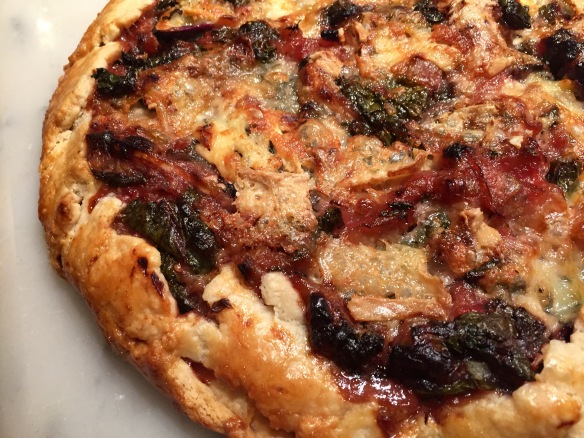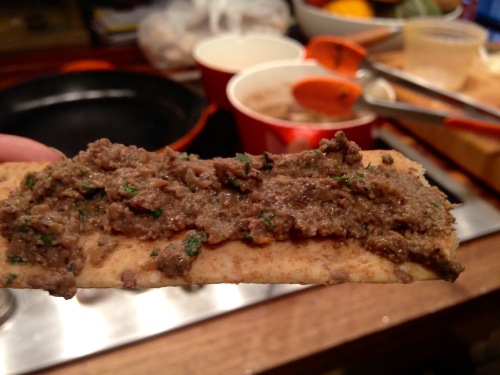Today was the launch of CSA season. For the next 22 weeks, I will swing by the artists’ studio/garage that serves as home to the Prospect Park CSA each Tuesday night, gleefully anticipating my allotment from Farmer Ted. This week brought green leaf lettuce, Red Russian kale, Happy Rich, Koji, scallions, breakfast radishes and a small pot of Genovese basil (which, my track record notwithstanding, I hope to keep alive long enough to make a few rounds of pesto).
Armed with the knowledge that such a bounty was just three days away, a sensible person would have spent Saturday morning sleeping off Friday night’s rooftop rosé and squid ink pasta with mussels and calamari. Instead, I awoke early and hit the farmers’ market. I told myself that, at the very least, I had to drop off the compost that was making it difficult to shut the freezer.
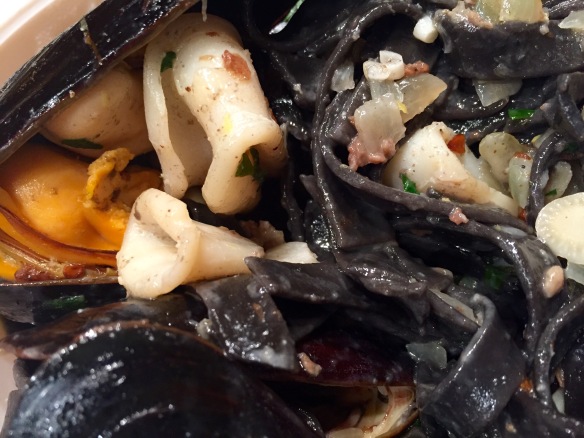
Naturally, I forgot the compost, leaving plenty of room in my bag for a pound of bacon, half a loaf of French sourdough, a bunch of kale, some collard greens, a handful of garlic scapes, and a whole mess of rhubarb. (This is my version of restraint.)
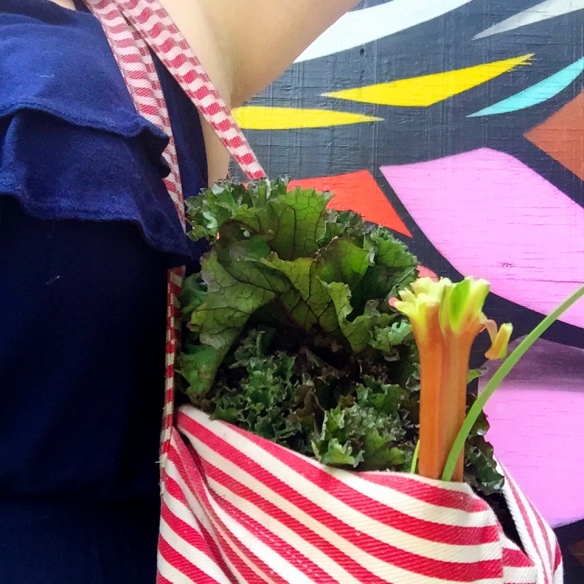
I hoisted my bag over my shoulder and headed toward home, pausing to say hi to Cathy, a fellow food blogger, and her food photographer friend. They asked what I had in mind for the rhubarb protruding awkwardly from my bag. Great question. I mumbled something about a rhubarb vinaigrette or a simple syrup for cocktails, both of which are fine, if limited, applications. But I had clearly purchased A LOT of rhubarb. We bonded over our mutual love or savory over sweet until I felt the siren song of my couch—and the leftover seafood pasta.
That evening found me babysitting my nephews, Wally and Hugo. Wally and I collaborated on a self-portrait, after which he demanded that I document his belly. (Oh, to be four.)
Bedtime was uncharacteristically easy, leaving me with a few hours to explore my sister’s snacks, my brother-in-law’s IPA stash, and the wonders of cable television. It was a lovely way to spend a Saturday night, but did nothing to remedy my looming vegetable crisis.
Fortunately, Louis was due for Sunday supper and Monica, Sara and I had failed to polish off that hunk of cheese on Friday night…
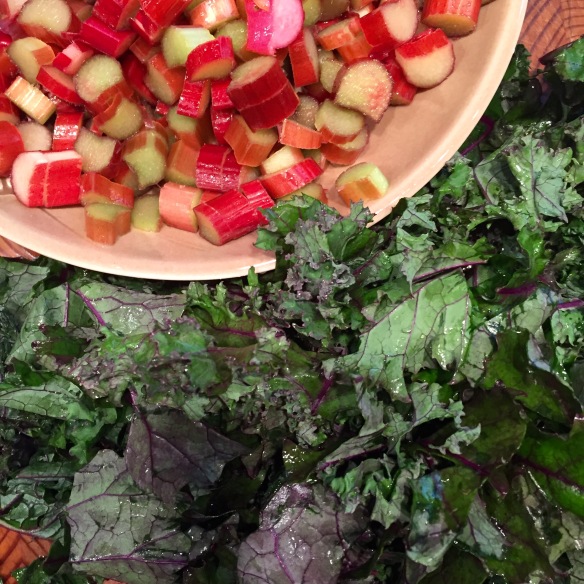
Rhubarb & Kale Tart
- 1 1/3 cups flour
- heaping 1/4 teaspoon salt
- heaping 1/4 teaspoon sugar
- 1 stick butter
- 3-5 tablespoons ice water
- 6 big stalks rhubarb
- 1-3 tablespoons sugar
- 3 tablespoons olive oil
- 1 large onion, thinly sliced
- 1/2 teaspoon fresh thyme
- pinch red pepper flakes
- 2 tablespoons white wine vinegar
- 1 bunch Red Russian kale, stemmed and roughly chopped
- salt and pepper
- 3 ounces Saint-André, brie or other soft, rich cheese
- 1/2 egg
- Fill a cup with water and a few ice cubes. Combine the flour, salt and sugar in a medium bowl. Cut the butter into small cubes and work it in with a pastry cutter if you have one. (Rumor has it you can use two knives. I made do with a mezzaluna, cleaning it out with a chopstick periodically. A pinching motion with your fingers should also do the trick. The goal here is a pea-sized crumble.) Gradually add the water, mixing the dough with your hands until is just comes together but is not sticky. Scatter some flour onto the counter, work the dough into a ball, and the press it into a disc using the palms of your hands. Wrap in plastic wrap and place it in the fridge for at least an hour.
- Toss the rhubarb with a tablespoon of sugar. Add 2 tablespoons of olive oil to a large skillet over medium-low heat. Add the onions and cook stirring regularly until they are soft and caramel colored. Taste the rhubarb and, if it seems excessively sour, add a little more sugar. Add the thyme and red pepper flakes to your onions, cook for a couple of minutes, and then stir in the rhubarb and vinegar. Let simmer, stirring regularly, until the rhubarb begins to fall apart and take on a chutney consistency. Add salt and pepper to taste.
- Scrape the onions and rhubarb into a bowl, bring the heat up to medium, and add the remaining tablespoon of oil. Add the kale in batches and cook until just wilted. Season with salt and pepper and set aside. Now would be a fine time for a nap.
- An hour out from dinner, preheat the oven to 400. Lightly flour the counter and rolling-pin. Roll the dough, flipping and dusting with flour as needed, until it’s the size of a small pizza. (You’re aiming for as thin as will reasonably hold together.) This may seem impossible at first, but give the dough some firm thwacks with the rolling pin and it will start to ease up. Gently transfer to a parchment-lined cookie sheet and return to the refrigerator until your dinner date confirms that he just got off the subway.
- Combine the rhubarb and kale and slather over the dough, leaving an inch or so around the edges. Fold the edges in. (You can get fancy with this by trimming and then crimping, but it won’t taste any different and, if you’re honest with yourself, you’re not a particularly patient person.) Scatter hunks of cheese over the top. Lightly beat the egg and brush it on the exposed dough. Pop this into the oven just as the buzzer sounds.
- Crack open a bottle of bubbly. By the time you finish the second glass, the crust should be golden brown. Let stand for 10 minutes or so and then use the parchment to gently slide the tart onto a serving platter.
Time to open that second bottle…
